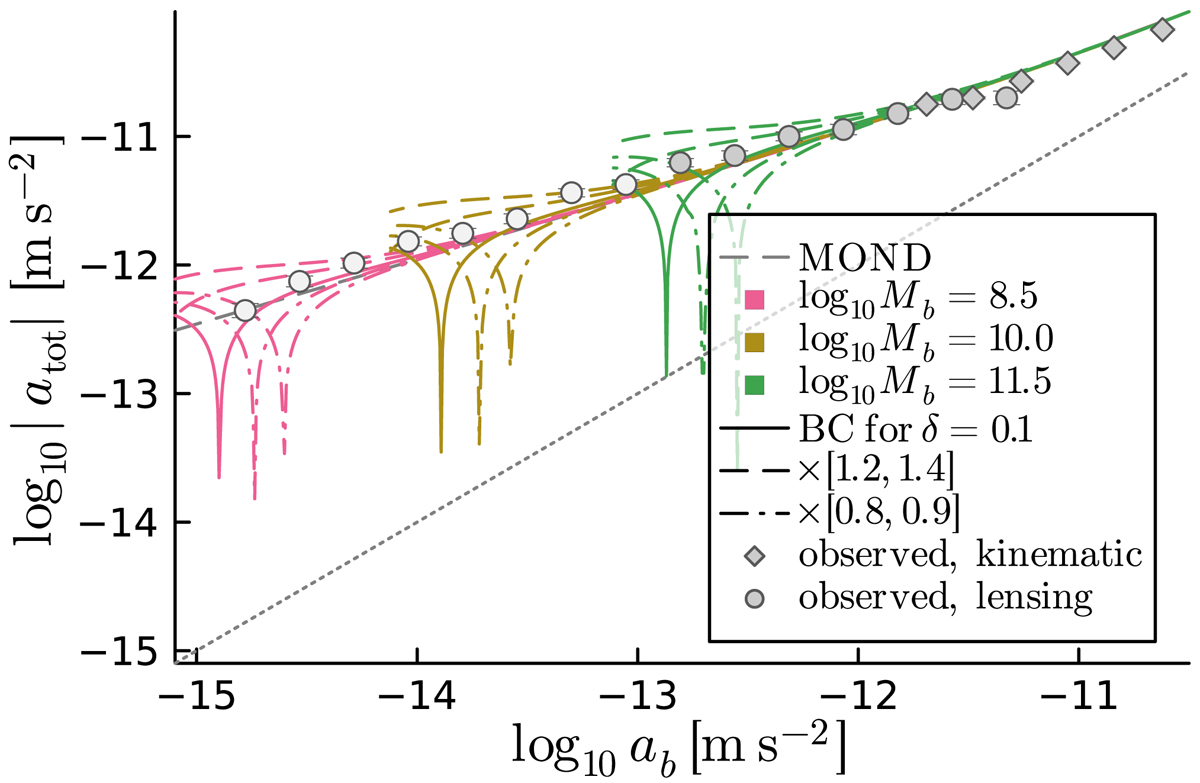Fig. 3.

Download original image
RAR for different baryonic masses and boundary conditions for numerical solutions with fG/m2 = 0.99 Mpc2. The solid lines are for boundary conditions where ![]() stays within a fraction δ = 0.1 from MOND up to the largest possible radius for a given baryonic mass Mb. Dash-dotted and dashed lines correspond to these optimal boundary conditions multiplied by factors [0.8, 0.9] and [1.2, 1.4], respectively. The dips all go to −∞ since they correspond to Meff = 0 (i.e., atot = 0), but this is not resolved numerically. The y-axis shows the modulus of atot. So after the dip, the direction of the accelerations is flipped. All solutions are cut off where the condensate density of the largest boundary-condition solution for a given Mb first drops to zero. The observed weak-lensing RAR does not include the hot gas estimate of Brouwer et al. (2021). We correct the observed weak-lensing RAR to be consistent with the M/L* scale of the observed kinematic RAR (McGaugh, priv. comm.). Data points below ab = 10−13 m/s2 have a lighter color since the isolation criterion is less reliable there (Brouwer et al. 2021).
stays within a fraction δ = 0.1 from MOND up to the largest possible radius for a given baryonic mass Mb. Dash-dotted and dashed lines correspond to these optimal boundary conditions multiplied by factors [0.8, 0.9] and [1.2, 1.4], respectively. The dips all go to −∞ since they correspond to Meff = 0 (i.e., atot = 0), but this is not resolved numerically. The y-axis shows the modulus of atot. So after the dip, the direction of the accelerations is flipped. All solutions are cut off where the condensate density of the largest boundary-condition solution for a given Mb first drops to zero. The observed weak-lensing RAR does not include the hot gas estimate of Brouwer et al. (2021). We correct the observed weak-lensing RAR to be consistent with the M/L* scale of the observed kinematic RAR (McGaugh, priv. comm.). Data points below ab = 10−13 m/s2 have a lighter color since the isolation criterion is less reliable there (Brouwer et al. 2021).
Current usage metrics show cumulative count of Article Views (full-text article views including HTML views, PDF and ePub downloads, according to the available data) and Abstracts Views on Vision4Press platform.
Data correspond to usage on the plateform after 2015. The current usage metrics is available 48-96 hours after online publication and is updated daily on week days.
Initial download of the metrics may take a while.


